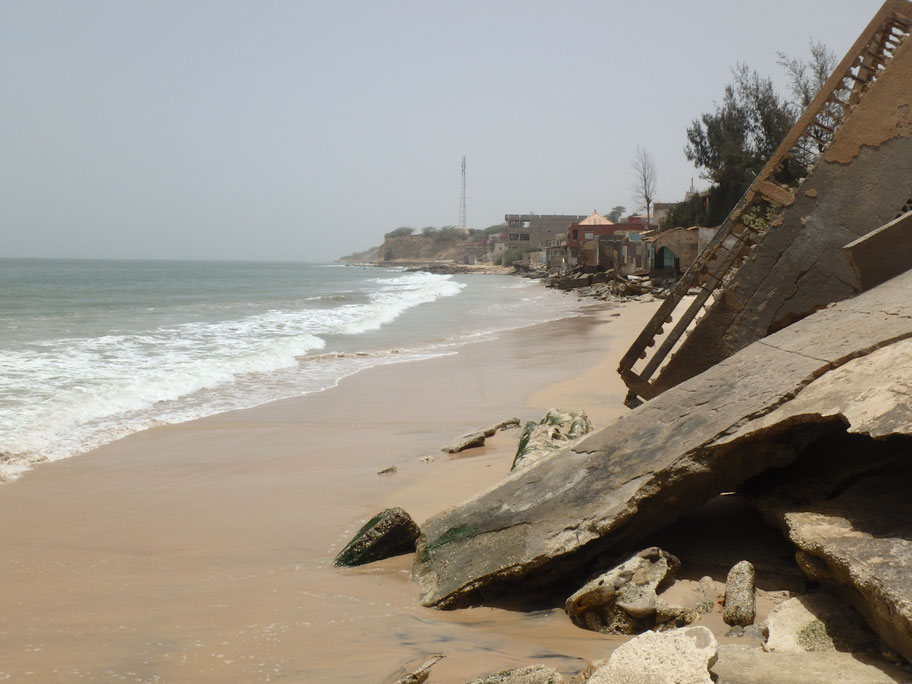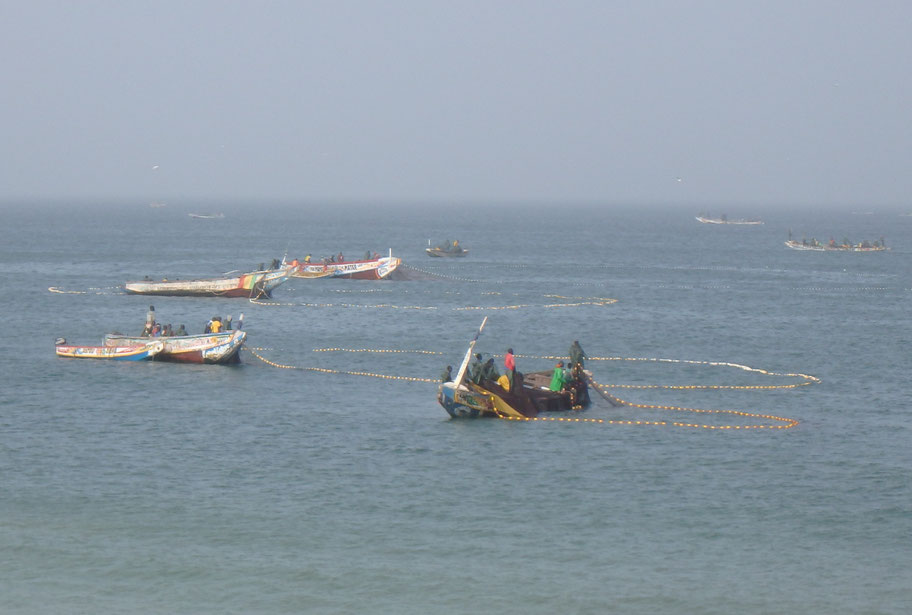
We arrived at Popenguine at the end of the Pentecost festivities. The streets were a mess of half-deconstructed market stalls, stumbling revellers and strewn plastic cups. Feeling tired from the
journey, we were thankful to find that – apart from pointing us in the direction of the ancient church – nobody paid us much attention. There were a few other toubabs*, enough to make us
unremarkable, but they mostly seemed to live there and (in May) there was little tourism to speak of.
*White or foreign people.


Down below the village, the sea was devouring property; concrete hung angular and strange.


The beach was empty and quiet; a good place to watch fishermen in the morning, but otherwise deserted. We played with the bodyboards, but the waves were breaking on the shore. Occasionally, at low tide, somebody jogged around the headland from the next village.





We stayed in Kër Cupaam which is linked with (and helps support) the nature reserve just south of the village. There are various animals living there, bushbucks and hyenas, but they remained allusive. I was happy enough to think they had a protected habitat and just enjoyed the birds.





I explored alone, as far as the next village and back up along the cliff spine, clambering over military bunkers from the Second World War. The wind was strong and, in my inappropriate shoes and tangling full length skirt, I was wary of the precipice.
Thinking of Mary Kingsley, my Victorian idol, I stood up straight (minus the corset) and observed my surroundings. At the end of the dry season, the land was crying out for rain. I wished for it too, but by then we would be gone.


Practical Information
At the time of writing (June 2018) £1 is around 744 CFA, $1 is 554 CFA and €1 is 655 CFA.
"Know Before You Go"
- I have written a whole post about what to pack and how to prepare for your trip to Senegal.
- In Senegal, the main languages are French and Wolof, though there are also many others.
- Whether Catholic or Muslim, the vast majority of Senegalese dress conservatively. Away from the beach, be respectful by covering your knees and shoulders (see my packing list for more details).
- To greet people say "Salaam Alaikum" (may peace be upon you) - to which if a person responds "Alaikum Salaam" (may peace be upon you too).
Accommodation - Kër Cupaam
Kër Cupaam was very basic, but relatively clean and pretty cheap (12,000 CFA for an en-suite double room with breakfast). Most importantly, it is run by the Regroupement des Femmes de Popenguine pour la Protection de la Nature, and profits are channelled back into the nature reserve and other community projects.
Visiting the Nature Reserve
Entry to the park is 2000 CFA per person. You can also hire a guide, which might be worthwhile, but we didn't (in favour of silence). Pay at Kër Cupaam and they will give you a ticket. Nobody is checking the entry, but you would be a real beast not to support the conservation effort.
Away from the Petite Côte, Mar Lodj and the Sine-Saloum Delta generally (further south) is another good place for walking.
Food
- The nearest shop, just north of Kër Cupaam sells bread (100 CFA) and you can buy onion sauce or pasta (100 CFA) to put inside from a lady just outside. Get one of these just before sunset and take it down to the beach to eat for a real treat.
- Resto Ami - in the south of Popenguine, on the same road as Kër Cupaam, this friendly restaurant serves carefully cooked meals with good flavours. We paid 8000 CFA in total - 3000 CFA for grilled fish (below) and 3500 CFA for fish kebab. Good value.

Transport
Coming from the south...
- Mbour to Sindia - ndiaga ndiaye/mini bus - 1000 CFA each + 1000 CFA for the bag.
- Sindia - Popenguine - small ndiaga ndiaye/mini bus - 200 CFA each.
Getting to the airport we paid 15,000 for a ride through Kër Cupaam. It was obviously too much, but we were tired of haggling. The car broke down several times along the way and I was (somewhat) vindicated in insisting
Travelling in Ramadan
Despite the famous Catholic church, there are many Muslims in Popenguine (including many of the staff at Kër Cupaam). It you want a tour, taxi or other non-food-related service, it is wise to do it before 5pm when everyone wants to go home to cook.
More on Senegal and The Gambia:
- "Un Peu" de la Petite Côte and Plenty of Pelicans at Mar Lodj, Senegal.
- From Bwiam to Basse, but mostly around Janjanbureh, then back west along the North Bank - The Gambia.
- Slowly, slowly up the river Gambia - from Sanyang to Bwiam.
- Tumani Tenda Eco-Lodge and Community - The Gambia.
- Rainbow Beach Bar and Lodgings, Sanyang - The Gambia.